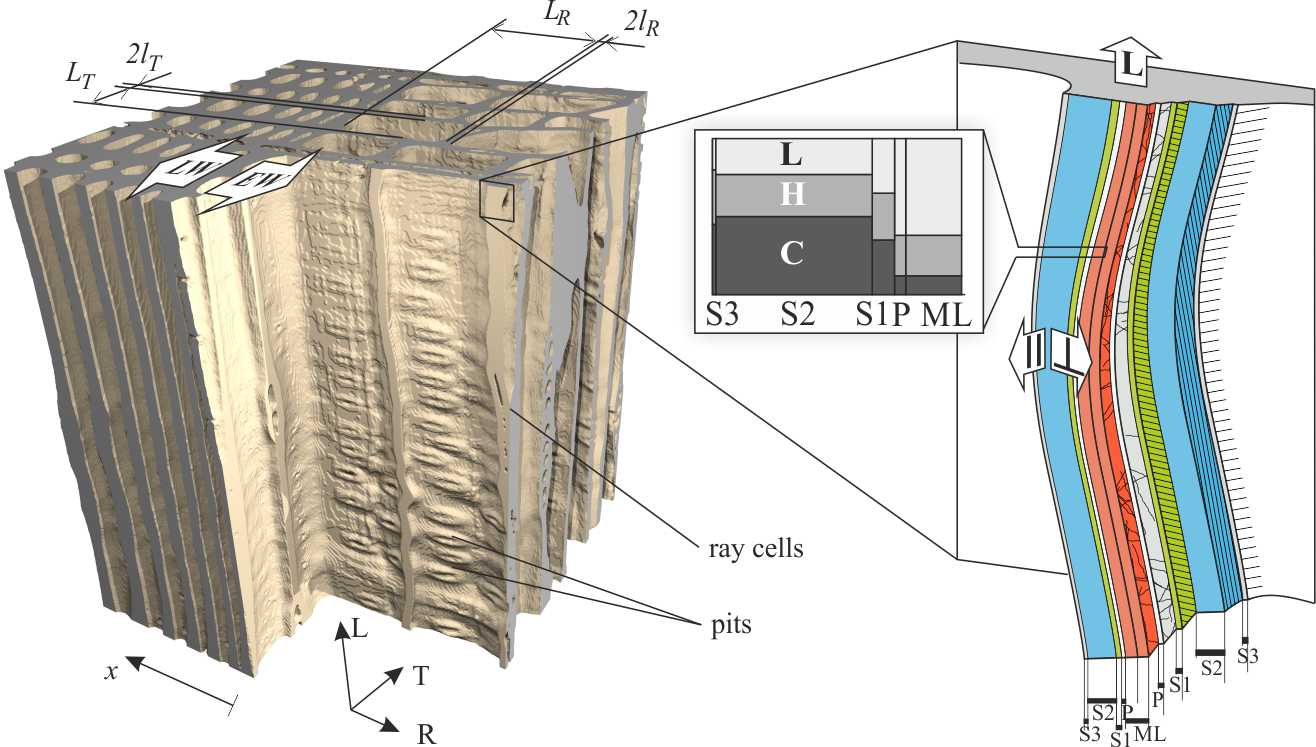Wood on Multiple Scales
Wood, with its hierarchical material structure is a fascinating natural material with a quite complicated hygro-mechanical behaviour. We simulate wood with bottom up (discrete element methods) and top down (Finite Element Methods) methods on all relevant length scales, with hierarchical material models and material point methods. We are interested in the general moisture dependent material behaviour, wood anatomy, fracture phenomena and mechanics, wood-adhesive interactions, and all the consequences for timber constructions.

Micro-structure of spruce at the growth ring interface with cell wall configuration .
Outreach wood bilayers:
- P. Grönquist, P. Panchadcharam, D. Wood, A. Menges, M. Rüggeberg, F.K.Wittel: Computational design of self-shaping wood gridshell structures, in preperation for nature Computational Materials (9/2019)
- P. Grönquist, D. Wood, M.M. Hassani, F.K. Wittel, A. Menges and M. Rüggeberg: Analysis of hygroscopic self-shaping wood at large-scale for curved mass timber structures, external pageScience Advances 5 (9/2019),eaax1311.call_made
- P. Grönquist, F.K. Wittel, M. Rüggeberg: Modeling and Design of Thin Bending Wooden Bilayers, external pagePLoS ONE 13 (10/2018), e0205607.call_made
Outreach wood modifications and hierarchical modelling:
- S.O. Olaniran, B. Michen, D. Mora, F.K. Wittel, E.V. Bachtiar, I. Burgert, M. Rüggeberg,: Mechanical behaviour of chemically modified Norway spruce (Picea abies L. Karst.) Part 1: Experimental mechanical studies on spruce wood after methacrylation and in-situ polymerization of styrene, Wood Science and Technology 53 (2/2019), 425-445.
- D. Mora, S.O. Olaniran, M. Rüggeberg, I. Burgert, H.J. Herrmann, F.K. Wittel: Mechanical behaviour of chemically modified Norway spruce: A generic hierarchical model for wood modifications, Wood Science and Technology 53 (2/2019), 447-467.
- A. Rafsanjani, D. Derome, F.K. Wittel, J. Carmeliet: Computational up-scaling of anisotropic swelling and mechanical behavior of hierarchical cellular materials, Composites Science and Technology 72 (6/2012), 744-751.
Outreach wood / adhesive failure:
- M. M. Hassani, F.K. Wittel, S. Ammann, P. Niemz, H.J. Herrmann: Moisture Induced Damage Evolution in Laminated Beech, Wood Science and Technology 50 (5/2016), 917-940.
- C. Lanvermann, P. Hass, F.K. Wittel, P. Niemz: Mechanical Properties of Norway Spruce. Intra-Ring Variation and generic behaviour of earlywood and latewood until failure, BioResources 9 (1/2014), 105-119.
- P. Hass, F.K. Wittel, P. Niemz, H.J. Herrmann: Generic failure mechanisms in adhesive bonds, Holzforschung 67 (2/2013), 207-215.
- F.K. Wittel, G. Dill-Langer, B.H. Kröplin: Modeling of Damage Evolution in Soft-Wood Perpendicular to Grain by means of a Discrete Element Approach, Computational Materials Science 32 (3-4/2004), 594-603.
Outreach general wood / adhesive behavior:
- M.M. Hassani, F.K. Wittel, S. Hering, H.J. Herrmann: Rheological Model for wood. Computational Methods in Applied Mechanics and Engineering 283 (2015), 1032–1060.
- C. Lanvermann, F.K. Wittel, P. Niemz: Full-field moisture induced deformation in Norway spruce: Intra-ring variation of transverse swelling, European Journal of Wood and Wood Products 72 (2014), 43-52.
- D. Derome, A. Rafsanjani, S. Hering, M. Dressler, A. Patera, C. Lanvermann, M. Sedighi Gilani, F. Wittel, P. Niemz, J. Carmeliet: The role of water in the behavior of wood, Journal of Building Physics 36 (4/2013), 398-421.
- P. Hass, M. Mendoza, F.K. Wittel, P. Niemz, H.J. Herrmann: Inverse determination of effective mechanical properties of adhesive bondlines, European Journal of Wood and Wood Products 70 (2012), 785–790.
- P. Hass, F.K. Wittel, M. Mendoza, H.J. Herrmann, P. Niemz: Adhesive penetration in Beech wood. Experiments, (2012) Wood Science and Technology, 46 (1-3/2012), 243-256.
- P. Hass, F.K. Wittel, S. A. McDonald, F. Marone, M. Stampanoni, H.J. Herrmann, and P. Niemz: Pore space analysis of beech wood: The vessel network, Holzforschung 64 (2010), 639-644.
Projects were mainly funded by SNF.
